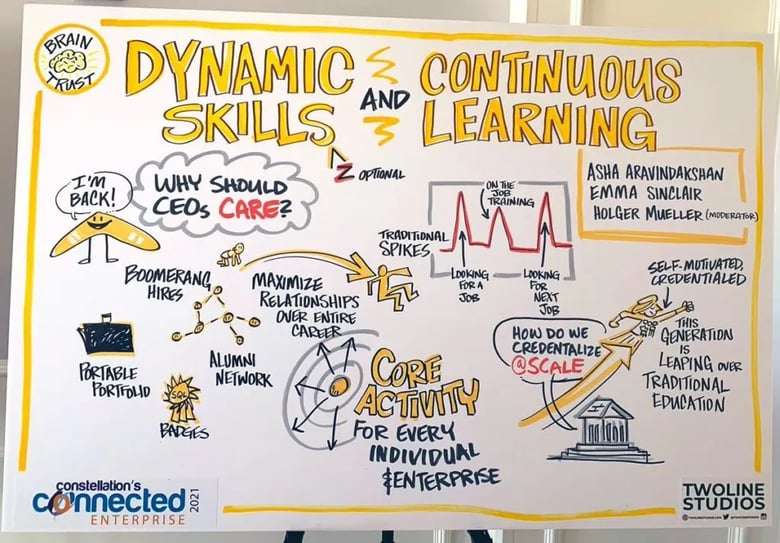Alumni Engagement Ideas To Drive Value For Your Professional Services Business
15 alumni engagement ideas that help teams ensure their community is ready to serve the needs of the business when needed.
Read more
We dig into why it's important for CEOs to extend dynamic skills and continuous learning opportunities to their alumni and employees alike.
Why should CEOs care about providing their corporate alumni with dynamic skills and continuous learning opportunities, you ask? After all, these are former employees who have left the organization. It doesn’t make sense to continue investing in their professional future. The doors are closed, and the relationships are over.
Or are they?
Leading organizations recognize that their human capital – current, former, and contingent – is their biggest asset. It’s also no longer the case to say that it’s the end of the connection when an employee leaves.
Instead, businesses look at ways to ensure communication stays open and the relationship remains on a good foot.
So, what is the drive behind extending continuous learning to alumni?
The short answer is to get uninterrupted access to business intelligence. Imagine boomerang hires with greater business knowledge and experience coming back into the fold. Or consider the convenience of connecting with skilled consultants who already have an inside scoop of the company or pressing business matters.
Today, innovative organizations realize that offering their alumni ongoing learning opportunities alongside their current employees can strengthen the business. Not only are they helping these people grow and evolve, but they’re also building relationships with them.
At the end of the day, alumni might come back to you after a period of upskilling and learning elsewhere. These people are positioned for quick assimilation and can inject new vigor and ideas into the mix.
Essentially, you’re upskilling future potential hires.

Companies that actively invest in all their workers’ ongoing education even after they leave will be the ones prepared for the workforce shifts taking place right now. Research shows the increased rate of change in the business sphere is making the lifecycle of skills and knowledge acquired shorter than ever.
To survive and thrive in an age that demands resiliency, employers and their workforce need to cultivate dynamic skills in these areas:
In addition to those, #CCE2021 speaker Asha Aravindakshan writes about the importance of transferable skills as part of continuous learning.
Also known as “portable skills,” transferable skills are skills and qualities that can be transferred from one job to another. They include:
From employees to alumni, businesses can teach these skills through proprietary courses. Alternatively, alumni can develop them through interaction on the network or through mentorship offered by the company.
In short, relevancy in the post-pandemic business space calls for new skills, quick involvement, and fast uptake in business projects. Alumni can tackle all three of those points much more efficiently than bringing someone new onboard.
Providing the learning ground for current and former employees to gain new skills ensures that you maximize the relationships you want to keep close.
After all, people start new jobs for new learning opportunities, among other reasons. Keep up the training momentum from employee to alumni, and you’re able to satisfy peoples’ inherent need for development over their entire career.
In turn, this will play a part in ensuring that you get to keep the communication lines open even with the people who walk out your door.
Sure, your employees may still leave the business and go on to become alumni. But, we ask you to rethink retention here.
Your most valuable talent doesn’t always carry a full-time label. They may be consultants, freelancers, contractors, or contingent workers.
Every organization can agree that they want to be known as a great place to work. Research shows that continuous learning contributes to this label.
For example, Indeed lists professional development as one of the top 15 factors in their survey of What Makes a Company a Great Place To Work.
If that’s not enough to convince the top brass, Recruiter Robert Half says 95% of executives find it somewhat or very challenging to find employees with the appropriate talents and skills. This is known as the ‘skills gap,’ and to address it, organizations have to adopt new perspectives when looking at their workforce development.
The solution, he says, lies in the adoption of a continuous learning approach. It will enable CEOs and CFOS to adapt to the disruptive change sweeping through corporates and organizations.
We have spoken about boomerang employees being people who return to work for your business. With the right educational opportunities, you can take it further and equip them to take over senior positions eventually. This is ideal for management succession and continued company operations.
The key here is to be completely transparent about the learning opportunities you’re providing. Be clear about how they will run the course to eventual management positions for the suitable candidates.
Importantly, keep realigning the outcomes over time to ensure the path remains a valid course of action.
Josh Bersin listed learning, skills, and career pathways as becoming business-critical in his report HR Predictions for 2022: Insights From The Report. Coaching will develop ‘power skills’ in everyone while talent intelligence and skills taxonomy are set to become the cornerstone of any organization’s people strategy.
Josh says: “A rich alumni community is paramount to any organization’s success in this new work-world.” In this case, rich means an engaged and diverse community filled with lifelong learners that benefit from the community as much as it helps from them.
NEWSLETTER


15 alumni engagement ideas that help teams ensure their community is ready to serve the needs of the business when needed.
Read moreJuly 1, 2025
One of the biggest challenges when building a virtual alumni network is keeping your alumni consistently engaged. Here are six engagement ideas.
Read moreJune 18, 2025
The secret to a successful alumni program is engagement. We've compiled the best corporate alumni engagement strategies that are proven to be...
Read moreJune 6, 2025
Build new revenue streams, save on recruitment and enhance your employer brand, all through the power of alumni.